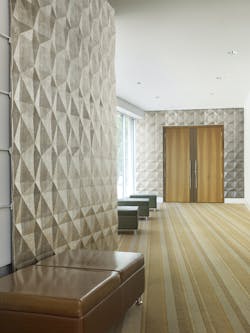We know that the more we fill our lives with touch screens and sleek surfaces, the more our brains will yearn for tactile elements in our environments, but one of the more unusual places we’re seeing texture is in wallcoverings.
Related: Are Touch Screens Affecting Interior Design?
Previously, walls were untouchable areas. In the last few years, however, they’ve taken on deep embossments and embellishments like metallic threads which add dimensionality.
According to Dan Brandt, director of product design for MDC, large-scale, highly visual wallcoverings—which includes embossing and metallic elements—have pushed ahead as an escalating trend. While statement or signature walls have been on a steady rise throughout the last decade, advancements in wallcovering technology allow design details to be expanded.
“[Previously] I think walls were just blending into a space, and designers are now really taking advantage of the materials available to them,” Brandt explained. “[Designers are] not just limiting [a statement wall] to a single focal point but using it throughout the space—anywhere you can highlight texture and go over the top. We’ve seen a very sharp increase in the [textural] product category alone. Decoratively, the quality of the finishes has improved, but it’s the texture that’s driving the interest levels.”
Here's more: Acoustics 101 for Architecture + Interiors
While dramatic walls are a natural element in entertainment spaces such as restaurants and hospitality lobbies, Brandt said that textural wallcoverings have made their way into every major market segment. The use is different in each space, such as using bold wallcoverings as a branding statement in an office or as a durable alternative in high-traffic healthcare lobbies and hallways, but designers are finding that tactile wallcoverings are able to perform a necessary function while providing a secondary purpose of drawing attention and adding to the design of an interior.
New patterns aren’t stopping at embossing or other textural elements. Brandt noted there is a mix of design elements coming out of the wallcovering industry, including metallic finishes that add a visual texture or printing custom logos, a product of new technologicalTech is not only allowing the creation of such designs but is also driving the demand behind them.
“Technology-based firms are leading the way,” he said. “The more progressive the design appears, the more likely [technology companies] are to use it. The actual texture they’re specifying has been pretty diverse: from small scale but very structured looks to over-the-top, highly creative [patterns] in large-scale.”
However, Brandt said the current use of textural designs is being done in a way that won’t make the space seem outdated in a few years.
Hand-picked: Pattern Set Free
“We see absolutely no signs of it slowing down. The interest level, year over year, continues to grow. I think we are very cognizant of the lines that we’re launching. We’re using [designs] that aren’t so trendy that they can’t be used or will look outdated in five or six years. These are materials being developed to stand the test of time, aesthetically and certainly [in] the durability of the product. We see it being relevant in the space for 10-15 years without any issue. We’re designing with that in mind.”
About the Author

Kadie Yale
Former Editor-in-Chief
Kadie Yale holds a BA in Industrial Design from San Francisco State University and a MA in Decorative Art History and Theory from Parsons the New School. In her role as editor-in-chief from 2015-2018, she led the interiors+sources team in creating relevant content that touches on sustainability, universal design, science, and the role of design in society.
